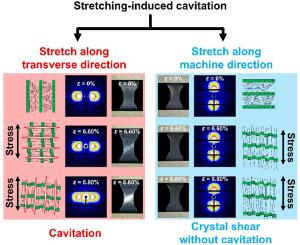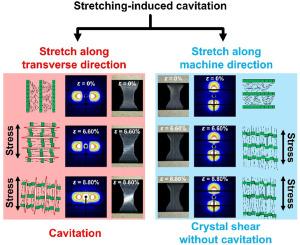聚偏氟乙烯-共六氟丙烯拉伸诱导空化行为的取向依赖性
IF 4.5
2区 化学
Q2 POLYMER SCIENCE
引用次数: 0
摘要
本研究通过对具有可控层状结构的铸膜的x射线原位散射分析,阐明了聚偏氟乙烯-共六氟丙烯(PVDF-HFP)中取向相关的空化动力学。通过设计两种不同的片层方向——平行于拉伸轴的法线和垂直于拉伸轴的法线——我们证明,只有当片层垂直于拉伸方向时,才会产生空化。随着退火温度的升高,空化临界起始应变从8.60%下降到6.60%,表现出对退火温度的敏感性。x射线散射证据揭示了连续的结构演变:片层破碎先于空腔成核,然后是从纳米级空洞到微米级缺陷的尺寸进展。正电子湮没寿命谱表明,在片层破坏过程中,非晶自由体积聚并进一步促进了非晶相内的空腔扩张。我们的研究结果表明,层状压裂在高度定向的PVDF-HFP体系中占主导地位,为设计机械坚固的多孔聚合物结构提供了新的见解。本文章由计算机程序翻译,如有差异,请以英文原文为准。


Orientation dependent of stretching-induced cavitation behavior of Poly(vinylidene fluoride-co-hexafluoropropylene)
This study elucidates the orientation-dependent cavitation dynamics in poly(vinylidene fluoride-co-hexafluoropropylene) (PVDF-HFP) through in situ X-ray scattering analysis of cast films featuring controlled lamellar architectures. By engineering two distinct lamellar orientations—normals parallel versus perpendicular to the tensile axis—we demonstrate that cavitation initiates exclusively when lamellae are orthogonally aligned to the stretching direction. The critical onset strain for cavitation exhibits annealing-temperature sensitivity, decreasing systematically from 8.60 % to 6.60 % with increasing annealing temperature. X-ray scattering evidence reveals a sequential structural evolution: lamellar fragmentation precedes cavity nucleation, followed by dimensional progression from nanoscale voids to micrometer-scale defects. Positron annihilation lifetime spectroscopy indicates that amorphous free volume coalescence during lamellar disruption further facilitates cavity expansion within the amorphous phase. Our findings establish that lamellar fracturing dominates in highly oriented PVDF-HFP systems, providing new insights for designing mechanically robust porous polymer architectures.
求助全文
通过发布文献求助,成功后即可免费获取论文全文。
去求助
来源期刊

Polymer
化学-高分子科学
CiteScore
7.90
自引率
8.70%
发文量
959
审稿时长
32 days
期刊介绍:
Polymer is an interdisciplinary journal dedicated to publishing innovative and significant advances in Polymer Physics, Chemistry and Technology. We welcome submissions on polymer hybrids, nanocomposites, characterisation and self-assembly. Polymer also publishes work on the technological application of polymers in energy and optoelectronics.
The main scope is covered but not limited to the following core areas:
Polymer Materials
Nanocomposites and hybrid nanomaterials
Polymer blends, films, fibres, networks and porous materials
Physical Characterization
Characterisation, modelling and simulation* of molecular and materials properties in bulk, solution, and thin films
Polymer Engineering
Advanced multiscale processing methods
Polymer Synthesis, Modification and Self-assembly
Including designer polymer architectures, mechanisms and kinetics, and supramolecular polymerization
Technological Applications
Polymers for energy generation and storage
Polymer membranes for separation technology
Polymers for opto- and microelectronics.
 求助内容:
求助内容: 应助结果提醒方式:
应助结果提醒方式:


